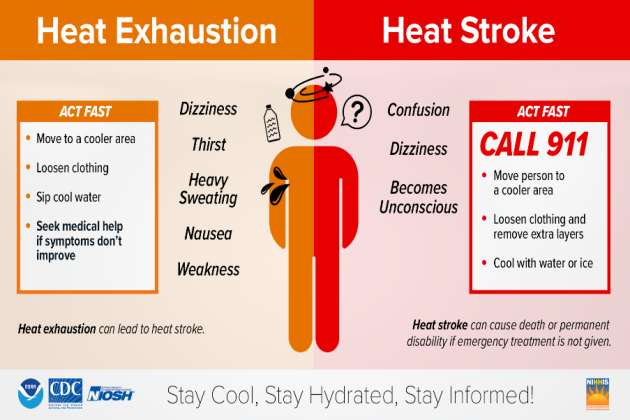Recognizing the difference and treatment for heat stroke, heat exhaustion
With the National Weather Service’s regular issuance of Excessive Heat Warnings and Heat Advisories, it might be prudent to review heat-related illnesses.
Did you know heat is one of the leading weather- related killers in the US?
Hundreds of individuals are killed each year by heat-related illnesses. Everyone is vulnerable to the effect of heat on the body; however, some of us are more vulnerable than others to heat, particularly young children, older adults, people with chronic medical conditions, and pregnant women.
The inability of your body to cool down properly causes heat-related illnesses.
Our body normally cools itself by sweating; however, sweating may not be enough under certain conditions.
When this happens, our core temperature rises rapidly and could cause brain damage or damage to other vital organs. Heat-related illnesses such as heat strokes and exhaustion are severe medical conditions and can lead to death if not treated quickly.
Heat cramps, sunburns, and heat rashes are all examples of other heat-related illnesses.
Heat-related illnesses are more likely to occur with high humidity, which causes sweat to evaporate slower, thus preventing the rapid release of heat from our body, especially if you are participating in strenuous physical activities or working outdoors.
Some of the symptoms of the most severe heat-related illnesses are listed below:
• Heat Cramps - Heat cramps are one of the first signs of heat-related illness and could lead to more severe heat exhaustion or heat stroke. The symptom of heat cramps is painful muscle cramps in the legs and abdomen accompanied by heavy sweating. First Aid includes giving sips of water (unless the person complains of nausea) and massaging the cramping muscles. If the cramps last longer than an hour, seek immediate medical attention.
• Heat Exhaustion – Heat exhaustion is a serious heat-related illness, and care should be taken when treating someone with it. Symptoms include heavy sweating, weakness, tiredness, and cool pale, clammy skin. The individual may also complain of muscle cramps, dizziness, nausea or vomiting, headaches, fainting, and weak pulse. The best first Aid for someone expe riencing heat exhaustion is to quickly move them to a cooler environment, preferably a well-air-conditioned one. In addition, apply wet cloths or have the person sit in a cool bath.
Offer sips of water if the person is nauseous or vomiting. Seek immediate medical attention if the symptoms worsen, begin vomiting, or if symptoms last longer than an hour.
• Heat Stroke – Heat stroke is a condition that requires immediate medical attention. Call 911 immediately or get the victim to a hospital immediately if you suspect the victim suffers from a heat stroke.
Delaying emergency treatment to a victim could be fatal.
Heat stroke symptoms include a throbbing headache, confusion, loss of consciousness, nausea, dizziness, and body temperatures above 103°F.
As mentioned above, heat stroke is a severe medical condition and requires immediate treatment; however, there are a few things you can do while you wait on the emergency medical services to arrive; they include moving the victim to a cooler, preferably air conditioning environment and try to reduce body heat by applying cool cloths or a cool bath. The main thing is do not give the victim any fluids.
Johnnie Thompson is a retired first responder and current city manager for the city of Meadowlakes.


